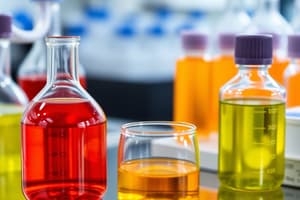Podcast
Questions and Answers
What defines a solution in terms of its components?
What defines a solution in terms of its components?
- The solvent is the smaller component in a solution.
- The solute is always a gas.
- The solute is in a larger amount than the solvent.
- The solution is a homogeneous mixture of solute and solvent. (correct)
Which method of quantitative chemical analysis uses chemical reactions?
Which method of quantitative chemical analysis uses chemical reactions?
- Gravimetric analysis
- Both B and C (correct)
- Physical methods
- Volumetric analysis
Which of the following units is used to express parts per million (ppm)?
Which of the following units is used to express parts per million (ppm)?
- g/mL
- g/L
- mg/L (correct)
- µg/mL
What is the molarity of a solution containing 5.00 g of NaOH in 750.0 mL? (Molar mass of NaOH = 40.0 g/mol)
What is the molarity of a solution containing 5.00 g of NaOH in 750.0 mL? (Molar mass of NaOH = 40.0 g/mol)
How many moles of Ca(NO3)2 are in a 75 mL of 0.25 M solution?
How many moles of Ca(NO3)2 are in a 75 mL of 0.25 M solution?
Which of the following is an example of a non-electrolyte solution?
Which of the following is an example of a non-electrolyte solution?
Which type of analysis primarily relies on the volume of reactants used?
Which type of analysis primarily relies on the volume of reactants used?
What is a key characteristic of a weak acid among the options provided?
What is a key characteristic of a weak acid among the options provided?
What is the primary focus of analytical chemistry?
What is the primary focus of analytical chemistry?
Which of the following is a major application of analytical chemistry?
Which of the following is a major application of analytical chemistry?
What does quantitative chemical analysis primarily determine?
What does quantitative chemical analysis primarily determine?
Which of the following methods is used in qualitative chemical analysis?
Which of the following methods is used in qualitative chemical analysis?
Which of the following is not a method of analytical chemistry?
Which of the following is not a method of analytical chemistry?
What type of chemical analysis provides no information about quantity?
What type of chemical analysis provides no information about quantity?
Which of the following best describes classical methods of analysis?
Which of the following best describes classical methods of analysis?
In forensic medicine, what role does analytical chemistry play?
In forensic medicine, what role does analytical chemistry play?
Flashcards are hidden until you start studying
Study Notes
Analytical Chemistry: An Overview
- Analytical Chemistry deals with the composition and structure of matter.
- Key applications include:
- Ensuring safety and quality of food, pharmaceuticals, and water.
- Environmental safety assessment.
- Disease diagnosis through analysis of biological samples.
- Forensic investigations
- Trade and commerce.
Types of Analytical Methods
- Classical Methods
- Qualitative - Identifies components present in a sample.
- Quantitative - Determines the amount of each component present.
- Instrumental Methods
- Use specialized instruments to analyze samples.
Qualitative Chemical Analysis
- Identifies the presence of elements or compounds in a sample.
- Provides no information on the amount of each component present.
- Examples:
- Iodide Test - Detects the presence of starch.
- Bunsen Flame Test - Identifies specific metals or ions.
Quantitative Chemical Analysis
- Determines the concentration of one or more components in a sample.
- Physical Methods - Measure physical properties related to analyte concentration (e.g., density, refractive index, light absorption).
- Chemical Methods - Involve chemical reactions between the analyte and a reagent.
- Reactions can be: Neutralization, precipitation, complexometric, or oxidation-reduction.
- Often involve the formation of new compounds.
- Main Classes of Quantitative Chemical Methods:
- Volumetric/Titrimetric Analysis
- Gravimetric Analysis
What is a Solution?
- A homogeneous mixture of two or more components.
- Solute - The substance being dissolved (present in smaller amount).
- Solvent - The dissolving medium (present in larger amount).
Expressing Concentration
- Molarity (M) - Moles of solute per liter of solution.
- Molality (m) - Moles of solute per kilogram of solvent.
- Mass Percentage (%) - Mass of solute divided by mass of solution, multiplied by 100%.
- Parts Per Million (ppm) - Mass of solute per million units of solution (used for trace concentrations).
- 1 ppm = 1 mg/L
- Parts Per Billion (ppb) - Mass of solute per billion units of solution (used for even lower trace concentrations).
- 1 ppb = 1 µg/L
Electrolytes and Nonelectrolytes
- Electrolytes - Substances that dissolve in water to form ions, conducting electricity.
- Strong – Dissociate completely (e.g., HCl, NaOH, NaCl).
- Weak – Dissociate partially (e.g., HF, CH3COOH).
- Nonelectrolytes - Substances that dissolve in water but do not form ions, not conducting electricity.
- (e.g., sugar, ethanol).
Studying That Suits You
Use AI to generate personalized quizzes and flashcards to suit your learning preferences.




